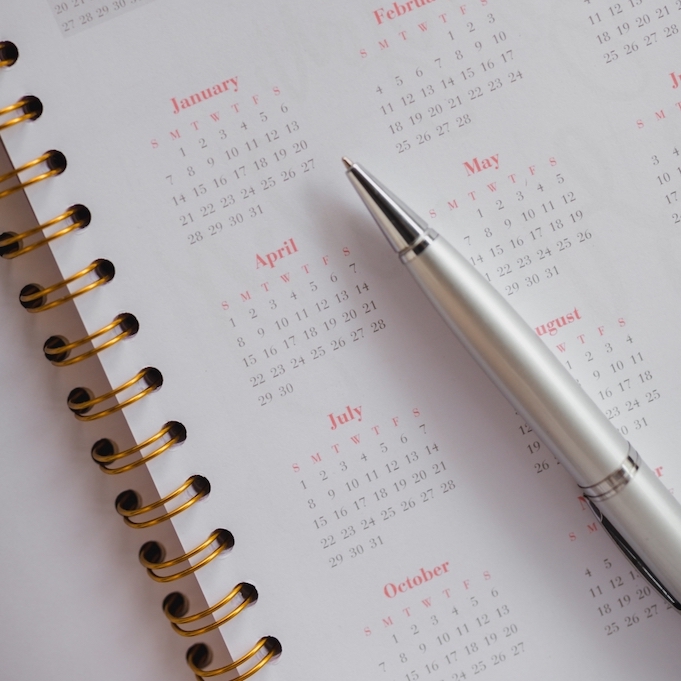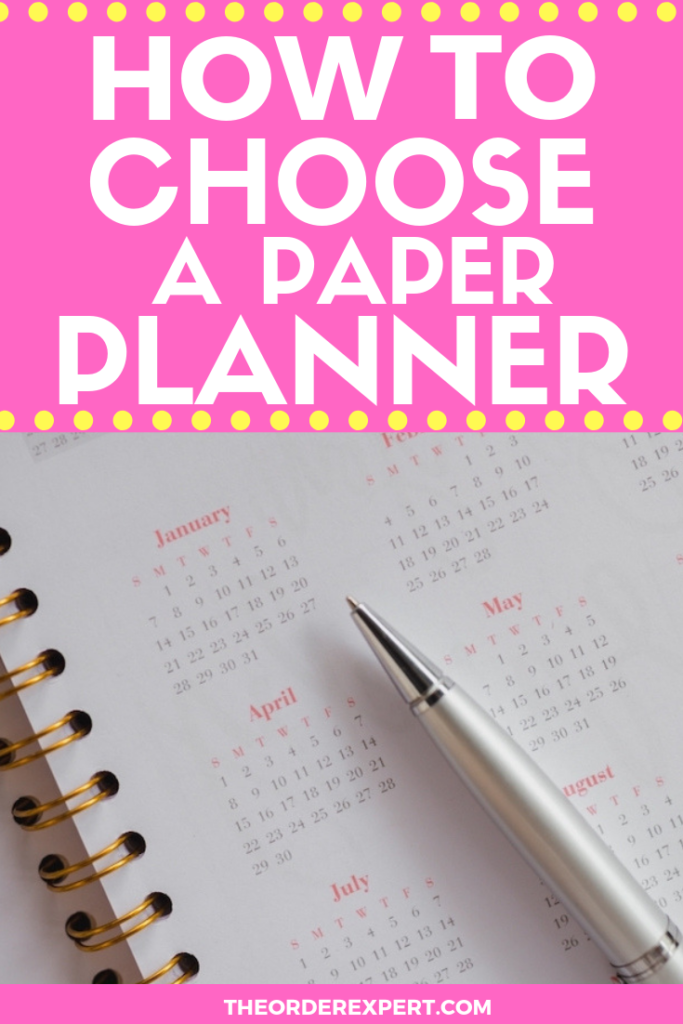
Are you wondering how to choose a paper planner to schedule your appointments, meetings, and projects?
If you’ve ever asked yourself, “What paper planner is best for me?,” then you might need some help sorting through the different types of planners and organizers available on the market today.
While variety is the spice of the life, making a decision about which paper planner to purchase amongst all that variety can be quite a tricky thing.
There’s so many different paper planner layouts, formats, and setups from which to choose.
Should you select a monthly dated planner?
Do you need a daily planner with lots of space for notes and to-dos?
And what size planner should you choose?
Would a pocket-sized planner be suitable for your needs or do you need a large, full-sized planner that will sit on your desk?
If you really want to make the most out of your selection, you’ll have to ask yourself a series of thoughtful questions.
In this post, I offer several tips to help you choose the right type of paper planner for your needs.
Take these tips to heart the next time you find yourself searching for a new planner, be it now, or several months down the road.
How to Choose a Paper Planner
Shopping for paper planners can be a lot of fun.
There’s tons of planners from which you can choose.
You’ll find planners in all different shapes, sizes, and layouts for everyone, and anyone, from professionals, students, homemakers, to retirees.
Since you’re going to be using your planner on a regular basis, it’s a good idea to do your homework so you’ll select a planner you’ll actually enjoy using.
What paper Planner is Best for Me?
Here are a few tips to help making the shopping process a smooth one:
Strongly consider shopping in a brick-and-mortar store.
Let’s face it: there’s no substitute for seeing a paper planner in-person.
Shopping in a traditional brick-and-mortar store allows you to gain some valuable feedback about planners.
You can feel the weight of a planner in your hands, take a good look at all the available layouts, glance at all the extra features, and get a better idea of the product sitting in your hands.
Of course, online shopping has it benefits too, which we’ll talk about in just a little bit.
Shop with an open mind.
Be willing to explore the different types of planners available.
You never know what you might discover at the store while shopping!
You could fall in love with a brand-new planner, uncover an iconic old favorite, track down a unique format that gives you some food for thought, or get a dose of much-needed inspiration for personalizing your own planner.
Put your personal preferences first.
What’s the best paper planner layout? Well, that all depends on your personal preferences and needs.
When choosing a planner, don’t second guess your personal preferences.
Even if a planner has been touted as the “world’s best planner,” it won’t be helpful to you if you despise the layout or the quality of the paper stock.
Take your time.
Remember, you’ll be using your planner for the foreseeable future.
At the very least, that will mean scheduling items for the next year!
That’s a long time to use a single tool, so don’t rush the purchasing process.
Take your time when conducting your planner research and avoid shopping when you’re rushed or stressed.
And most importantly, don’t forget to take ample notes on your favorite designs and brands.
Before visiting the store
Review your old planner.
Before you head off to the store, it’s worth taking a few minutes to flip through the pages of your previous planner.
This exercise is a smart and simple way to collect valuable data from a year’s worth of use.
Here are some questions you can ask yourself to uncover some valuable nuggets of information:
- What did you absolutely love about the layout of your planner? What made your heart sing every time you opened up your planner? Conversely, what didn’t you like about the layout? What drove you up the wall every single time you glanced…or even thought about your planner?
- Which planner features were useful? Which features weren’t? Did you enjoy using the little checkboxes for your daily to-dos? Was there a bonus notes section in the back of the planner for your thoughts and musings? Was the planner missing a yearly calendar or holiday reference guide?
- What features would you like to have in your next planner? Based on the above information, which features would you love to have in your next choice of planner? Which features are must-haves and which features are would-be-nice-to-have?
- Was your planner size just right for your needs, or was it too small or large? Were you satisfied with the size of the planner over the course of the year? Was there ample room for you to enter information, refer to dates, or simply handle on a day-to-day basis?
- Was your planner used to track basic or detailed information? Did you need to write in daily entries, or did a weekly or monthly layout work well for your needs?
- Was your planner used for work, school, or home? Will it be used for the same purpose this year? Or will this planner be used for a different purpose or project entirely?
- Was your planner transported or carried from place to place on a daily basis? How did the planner hold up over the course of your travels? Is it still pretty much intact or is it shredded beyond recognition?
And what if you don’t have an old planner handy? For starters, you can think about the features of a planner you’ve used before in the past.
Another idea is to consider how you like saving, storing, and viewing information. This will help you better navigate the layout considerations of your planner.
Be mindful of your budget.
While you should strive to find a planner that meets your needs, it’s worth bearing in mind that you needn’t break the bank in order to do so.
You don’t have to spend a lot of money in order to get good value. Generally speaking, you can purchase a decent, basic planner for around $40.00 USD or less.
What if money is a bit tight? Don’t worry, there are some ways to offset the cost of your brand-new planner.
You could cash in that holiday gift card, bring your lunch to work for the next two weeks, ask for a planner as a birthday or graduation gift, or make use of current store coupons, or brand promotions.
It’s also worth noting that just because a planner is more pricey, doesn’t necessarily mean it will be the best investment for you. It’s best to take into consideration the overall features of the planner.
Plan on visiting different stores.
As we’ve discussed earlier, there’s no substitute for inspecting a potential paper planner in person.
You can literally get a feel for the planner’s dimensions and features.
That being said, you should consider visiting different stores to find your planner.
You can visit any combination of office supply stores, department stores, bookstores, closeout stores, big box stores, boutiques, and craft markets. Be sure to ask for assistance from store staff if you need it!
What if you should happen to come across a planner that you’d love to use, but it is out of stock, or in an undesirable color or pattern?
Good news: you can do a search to see if you can order the product in question online.
Consider using online shopping as a backup.
What if you live in an area where there aren’t a lot of stores to do your planner shopping?
What if you are physically unable to travel to do your planner shopping? This is where online shopping can come in handy.
Online shopping allows you to do your planner shopping from the comfort of your own home.
You can do some extensive research with just the click of a button and have products delivered to your front door.
If you are going to purchase your planner via online shopping, be sure to read and fully understand the seller’s return, exchange, and refund policies, if any.
You may decide a planner isn’t what you thought it would be upon closer inspection, and may want to return it for an exchange or refund. Otherwise, you may be stuck with a planner you don’t want.
At the store
Review planner sizes.
Paper planners come in a wide variety of sizes.
Having said that, it’s important to realize that no one planner-size can do it all. Each have their own unique strengths and weaknesses.
Here’s a list of common planner sizes along with some of their pros and cons.
Which planner size will work the best for your needs? Think about how you intend to use your planner over the next twelve months.
Mini (2 5/8 inches x 4 1/4 inches)
Pros: This is a great choice for someone who commutes and/or travels frequently and doesn’t want to be bogged or weighed down with a giant planner. This layout offers a nuts and bolts view of one’s calendar.
Cons: Unfortunately, the mini-size can only hold limited amount of information. It may be difficult to write in, as well as read. What’s more, it can easily be misplaced.
Pocket (3 1/4 inches x 4/34 inches)
Pros: This planner size is easily transportable. It can fit into one’s pocket in a pinch and is a great size for quick reference.
Cons: This size planner may be awkward for some people to write in and read. In some cases, the product may not lay completely flat.
Personal (3 3/4 inches x 6 3/4 inches)
Pros: This planner can be transported easily. It allows easy tracking of both details and general information.
Cons: This size may just be a tad too small for some people. It may be awkward for some people to write in as well as read, and it may not lay completely flat.
A5 (5 3/4 inches x 8 1/4 inches)
Pros: This sized planner can be transported should the need arise. It makes for a nice hand-held planner.
Cons: Unfortunately, this size may not fit in smaller purses or bags. This planner may be heavy because of it’s size, paper weight, or total number of pages.
A4 or Letter (8 1/2 inches x 11 inches)
Pros: This planner allows you to easily write inside of it and read what you’ve written. It may lie flat when placed on a desk.
Cons: This size may not fit in smaller purses or bags. Like the A5, this planner may be extremely heavy because of size, paper weight, or total number of pages.
Review planner layouts.
Paper planners have different layouts.
Some allow you to track details, while others allow you to track general information. It’s certainly worth taking into account planner layouts as you make your selection.
Here’s a list of common planner layouts:
- Daily. This includes all 365 days of the year. This may include weekly and/or monthly calendar overviews.
- Weekly. This includes a listing of 52 weeks of the year. This may include monthly calendar overviews.
- Monthly. This includes the 12 calendar months of the year.
- Combination. This can be any combination or permutations of the above layouts, such as daily/weekly, weekly/monthly, daily/monthly, and so on.
Which of the above planner layouts do you think will suit your needs?
As you review the basic planner layouts listed above, you should also take into account the following planner features:
- Days. Do weekdays and weekends receive equal layout spacing? Is there more of a focus on weekdays versus weekends?
- Hours. Are daily hours listed? If so, what are the range of hours? Do they stretch from 5:30 A.M. – 10:30 A.M., 9:00 A.M. to 5:00 P.M., etc.?
- Paper style. Are pages lined, with narrow or wide ruling, are they graphed, or are they blank?
- Paper weight. Is the paper stock thin, medium, or heavy? Is the paper bleed-proof? Can you easily turn the pages of the planner?
- Tabs. Does the planner have built-in tabs for days, weeks, months, or other features?
- Weight. Is the planner overly light or is it super heavy? What seems light now may seem like a ton later!
- Binding. Is the planner spiral bound or sewn? Does the planner lie flat when opened?
- Additional features. Does the planner have built-in pockets, removable rings, or place mark tassels?
- Recycled. Is the planner made from 100% recycled components or partially recycled components?
Which of the above planner features do you find to be the most useful or helpful to you?
Narrow down your options.
By now, you should a couple of paper planners in the running. But which one should you choose?
You’ll want to consider the points we discussed earlier in the post as well as your personal preferences and planner features.
Here’s a list of planner preferences to consider when it comes to making your final selection:
- Do you like the outside color or pattern of the planner? If you cannot stand the theme or scheme of the planner now, there’s little chance you’ll fall in love with it at a later date.
- Do you like the colors and designs on the inside of the planner? Similar to the point above, you should find the planner theme pleasing to the eye. You should strong reconsider something that doesn’t float your boat.
- Do you like the feel and weight of the paper in the planner? Some planners have very thin paper stock, while others are heavier in weight. Does paper stock matter to you? If so, what will make or break your selection?
- Do you like the feel and weight of the planner cover? Planner covers can range from thin card stock to heavy plastic sheets. Is what you’re holding in your hands pleasing to the touch?
- Is the planner the right size for your needs? Are you satisfied with the size of the planner for your lifestyle, project, or assignments?
- Will you be comfortable writing inside of the planner? Is there enough room for you to write clearly and legibly?
- Are there any bonus features (maps, conversion charts, contact forms, emergency numbers, inspirational quotes, planning tips, note pages, blank pages, etc.) that you absolutely adore? If so, what are they? How will they be useful to you in the following year?
- Will the planner fit comfortably in your purse, briefcase, or backpack? If you’re going to carry your planner with you, day-in and day-out, it’s worth checking to see if you can actually fit a potential planner in your bag or purse. Be sure to ask a store staff member or associate for assistance with this.
- Will you be comfortable reading or reviewing the planner? Does this planner have everything you need for your current lifestyle and goals? Can you see yourself using this planner every day or nearly every day for the next year?
And there you have it! Hopefully, this post has given you some solid questions to ask yourself when it comes to choosing a paper planner.
In sum, have fun choosing your paper planner and be sure to enjoy it for months to come!
How about you? How do you use (or are going to use) paper planners in your work and personal life? What do you find to be the most difficult part in choosing a planner? What are your preferred brands, formats, layouts, and styles of planners? Join the conversation and leave a comment below!






What an excellent comprehensive guide! Even though I’ve stopped buying paper planners (for now, at least), that’s one thing I’ve never skimped on. It’s not a bargain if it doesn’t work the way you need it to!
Thanks very much, Janet. I couldn’t agree more. I’m a huge fan of paper planners and am quite selective about designs and formats. I’ve been known to spend a good amount of time comparing paper planners at the store before I make my final selection(s)!